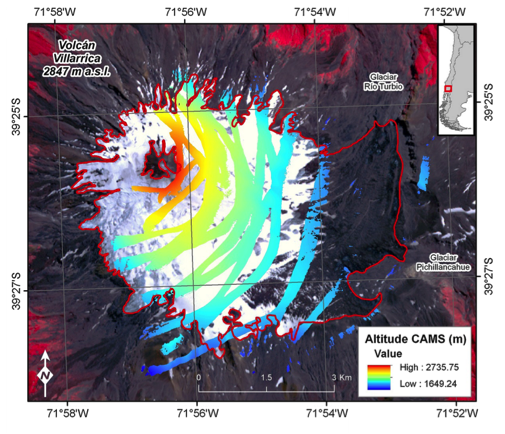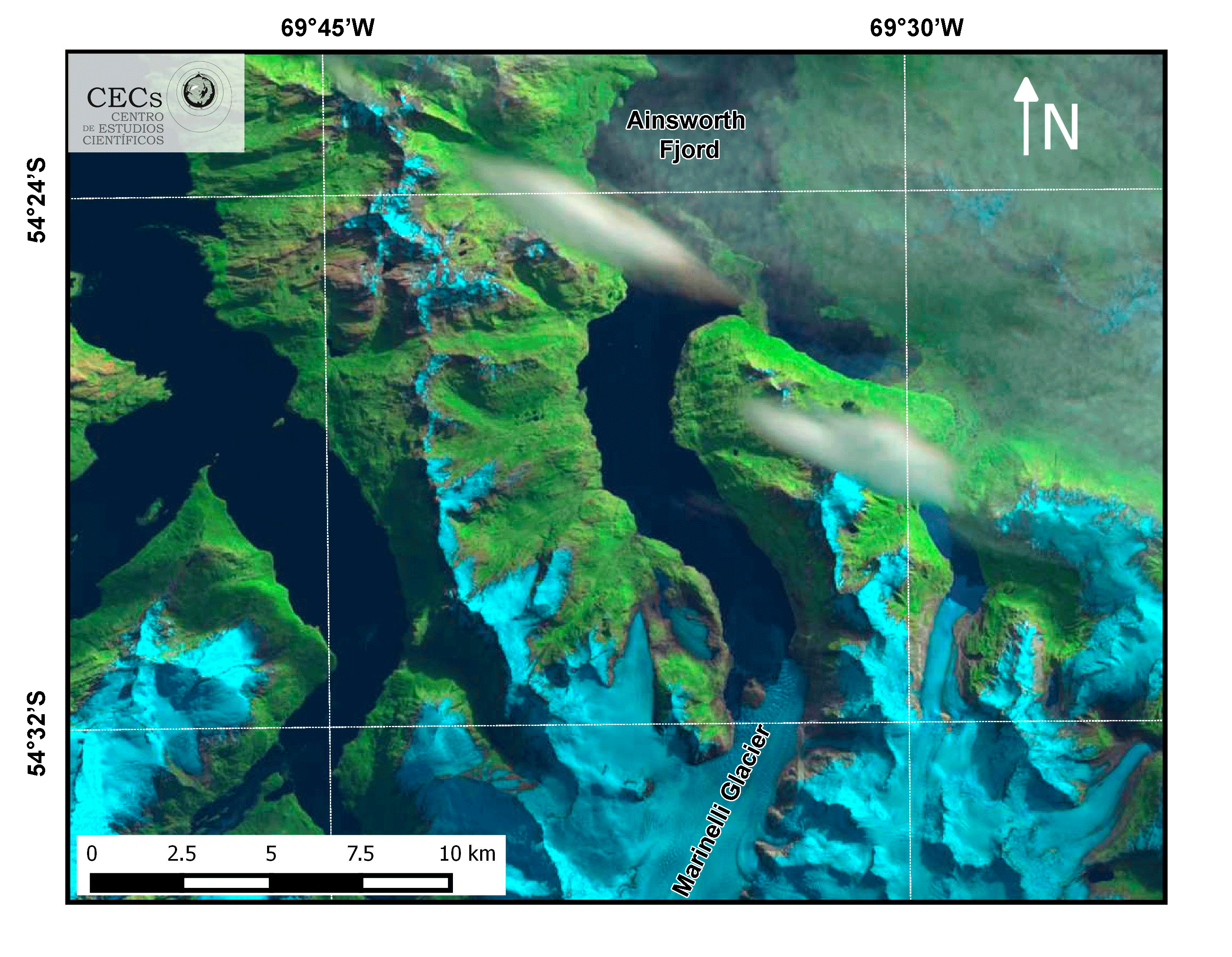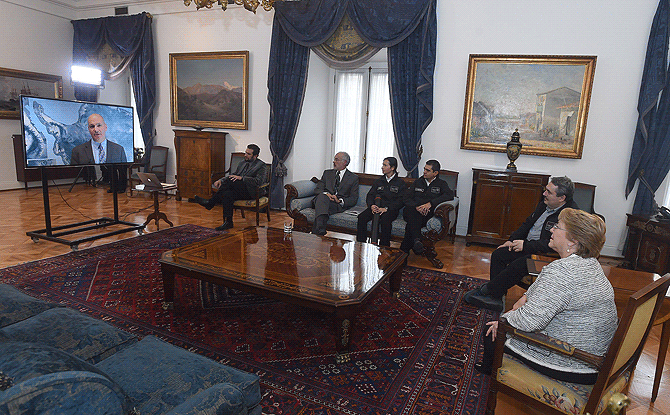|
Measurements and scientific findings will serve to improve assessments of risk to the population close to the massif, and will also improve emergency plans against new volcanic eruptions

In a collaborative work with the Bavarian Academy of Sciences of Germany and the Universidad Mayor, researchers from the Glaciology laboratory of the Center for Scientific Studies have found using airborne radar and laser measurements that the Villarrica Volcano (39° S) accumulated a total of 1.17 ± 0.1 km3 water-equivalent in 2012, which corresponds to 37 % of the estimated volume in 1961. This decline is explained by the reduction in glacier surface area and ice thinning in the past 51 years. The research results were recently published in Natural Hazards.
|
|
Read more...
|
|
|
The newly found ice surfaces are included within the first glacier inventory of Cordillera Darwin. The CECs glaciology team also made precise measurements of glacier retreat at this icefield, located in Chile’s Southern Austral region.

Figure 1. Frontal variations of Marinelli Glacier since 1913
The published work by CECs glaciologists Francisca Bown, Andrés Rivera y Claudio Bravo, together with Pablo Zenteno and Fiona Cawkwell, provides a cadastre of glaciers of the major mountain centres south of the Strait of Magellan (54°S). This includes Cordillera Darwin and Monte Sarmiento (both on the main island, Isla Grande of Tierra del Fuego), Santa Inés Island and Hoste Island.
A total of 1,681 glaciers were accounted in the inventory, amounting to a total ice cover of 3,289.5 km2. Previous estimates in this region indicated an ice cover of only 2,500 km2, which implies an additional finding of 789 square kilometres of glaciers. This is not attributable to glacier advance, but is a result of more precise glacier delineation as explained in this research, published as book chapter in “GLIMS: Global Land Ice Measurements from Space”, which is based on modern satellite images unlike previous studies where former data collection techniques were employed. Satellite imagery also reveals glacier trends in this region. A striking example is Marinelli Glacier (Figure 1) which has undergone a 15 km-retreat since 1913. Retreats are also registered for Conway and Schiaparelli glaciers, which were photographed by young Charles Darwin during his voyage onboard the HMS Adventure and Beagle between 1826 and 1836.
|
|
Read more...
|
|
CECs scientists discover a new subglacial lake in West Antarctica. |
 |
 |
 |
|
The finding is reported in an article published on May 22, 2015 in "Geophysical Research Letters", entitled: "Subglacial Lake CECs: discovery and in situ survey of a privileged research site in West Antarctica".
The lake is the first to be discovered by researchers from outside the US and Europe. It is an encapsulated body of water and it is particularly stable. Subglacial lake CECs is located at only 10 geographic degrees from the South Pole, and it has an area of at least 18 square kilometers.

Early indications of a subglacial lake were detected in the summer of 2014, at an approximate latitude of 80 S and only 10 geographic degrees from the South Pole, while “CECs 1” mobile station was journeying across the central plateau of the West Antarctic Ice Sheet. On 21st January 2014, on-the-ground radar measurements showed subglacial returns that were different from those observed until then, indicating the presence of a massive body of water at a depth of a little more than 2.6 kilometres below the ice. An immediate first mapping with ice-penetrating radar confirmed the finding. The research team returned in 2015 and completed an exhaustive mapping. These results were then analysed in detail and the findings sent to the specialised journal “Geophysical Research Letters”, where the published scientific article appeared just recently, on 22nd May of this year. The authors are all members of the Glaciology Laboratory at CECs: Andrés Rivera, José Uribe, Rodrigo Zamora y Jonathan Oberreuter.
|
|
Read more...
|
|
|
The President, Michelle Bachelet, met with CECs Director Claudio Bunster and the CECs glaciology researchers who discovered the lake, Andrés Rivera, Rodrigo Zamora and José Uribe.

The photograph shows the attendees listening to Waleed Abdalati, former NASA Chief Scientist, currently Director of CIRES and a member of the CECs International Advisory Committee, who via video message expressed his views on the importance of the Glaciology program at the Center and the relevance of the discovery of Subglacial Lake CECs.
---
Source: Presidencia de la República.
|
|
Robert Thomas was born on June 1st, 1937, in Hoylake, United Kingdom. He died on February 2nd, 2015, in Gorzow, Poland, as a consequence of a stroke that he suffered in early January.

The Center for Scientific Studies expresses to his family its condolences on the death of Robert Thomas, a prominent scientist and visiting professor at CECs since 2003.
Bob earned his Physics degree at the University of Liverpool in 1959, and his PhD at the University of Cambridge in 1973. He worked as a glaciologist and meteorologist at the British Antarctic Survey in the periods of 1959 to 1963 and 1965 to 1973. In the Seventies he was Associated Researcher at the University of Nebraska and Associated Visiting Professor at the University of Maine in Orono.
Bob was always interested in Scientific Research in Antarctica and Greenland. His Antarctic work focused on the floating ice shelves, developing models on the interaction between platforms and glaciers flowing into them.
|
|
Read more...
|
|
|
|
|
Start Prev 1 2 3 4 5 6 7 8 9 10 Next End
|
|
Page 5 of 41 |
